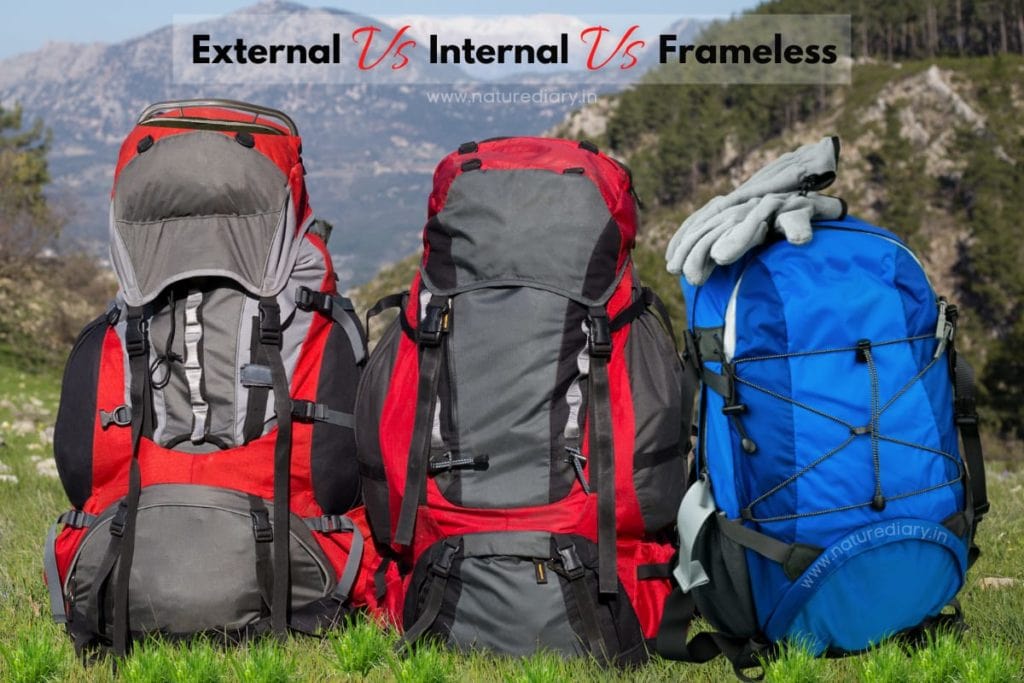A backpack is an essential travel gear for every tourist. Internal frame, external frame, and frameless backpacks are the types of backpacks depending on the frame that sits away from your torso, increasing ventilation and reducing the sweat factor.
Therefore, it would help if you knew their differences and similarities. By comparing External Frame Vs. Internal Frame Vs. Frameless Backpack, understand their pros and cons to find out which is better and why. This article will provide detailed information on each so that you can decide which type of travel backpack is worthiest to your needs.

External vs. Internal Frame Vs. Frameless Backpack
| Point Of Difference | External Frame Backpack | Internal Frame Backpack | Frameless Backpack |
|---|---|---|---|
| Storage Space/ Capacity | External frame backpacks have maximum storage space and can carry very heavy loads. | It has less storage than the external ones and can carry medium to heavy loads. | A frameless backpack does not have enough space to store items. It can carry lightweight loads. |
| Weight | External frame backpacks are the heaviest of all types of backpacks. | Internal frame backpacks are more lightweight than external frame backpacks. | Frameless backpacks are the lightest backpacks available due to the absence of the frame. |
| Stability | This travel backpack is unstable as the body fit is not as perfect as the internal backpack. | The internal frame backpack is the most stable due to its frame design to align with your torso. | The stability of the backpack depends on the straps holding the backpack. |
| Packing & Coverage Space | The external frame backpack is not as easy to store as the frameless one. However, it covers less space than the internal backpacks. | The internal frame backpack requires the maximum amount of coverage space for its storage. | A frameless backpack can be stored very easily and requires minimal coverage space compared to internal and external frame backpacks. |
| Durability | External frame backpacks are the least durable as the frame is exposed to lots of wear and tear during travelling. | This backpack is more durable than the external frame backpack but slightly less durable than the frameless backpack. | It is the most durable travel backpack compared to external and internal frame rucksacks. |
| Ventilation | External frame backpacks offer maximum ventilation and keep the body cool and sweat-free. | Internal frame backpacks usually offer less ventilation than external ones. | Since the backpack lies just against the back, it offers minimal air circulation and hence almost no ventilation. |
| Maintains Shape | It maintains the body’s posture and supports the spine. | This backpack also maintains the body posture and keeps your spine aligned. | Frameless backpacks, however, do not maintain the proper shape and can hurt your back. |
| Comfort | External frame backpacks are not so comfortable when compared. | Internal frame backpacks are comfortable to wear. | Frameless backpacks are comfortable, however, it directly depends on how the bag is packed. |
| Cost | External frame backpacks are the most expensive backpacks among the three. | Internal frame backpacks are more expensive than frameless backpacks but less expensive than external frame backpacks. | Frameless travel backpacks are the most cost-effective option. |
What is External Frame Backpack?
An External Frame Backpack has a frame that separates from the pack, designed to hang from your back. These backpacks have a harness attached to a waist belt that holds the bag in place. Made of lightweight metal such as aluminium and reinforced synthetic polymers, external frame backpacks can carry bulky loads of more than 20 Kg.
In this type of travel backpack, the load is transferred directly to the shoulders via the non-flexible straps, which prevent damage from carrying it in the long term. Moreover, it has additional space above and below for attaching sleeping bags and other equipment.

Advantages of External Frame Backpack
1. Highest Load Capacity
External frame backpacks can carry the heaviest loads up to 50 Kg for an extended period during long trekking or expeditions. As an external backpack, it provides structural support that helps to lessen the weight of the load. It allows for comfortable and easy positioning of the load, making the carrying process easier with an upright walking posture.
2. Increased Ventilation
The external frame backpacks allow for superb ventilation by allowing air to flow into the backpack through the fabric. The fabric of the best quality trekking bag is made of breathable material, which not only keeps your clothes fresh throughout the hike but also allows perspiration to escape from your body. When the temperature is low, it keeps your back, and torso warm as air doesn’t circulate to the back of the backpack as it does when the backpack is internal.
3. Huge Storage to Accommodate Travel Gear
External frame backpacks are more spacious than the internal frame and frameless backpacks. They are manufactured with many pockets and compartments to organize your trekking and camping essentials easily. Having a huge storage space, you can easily accommodate all your travel essentials like a sleeping bag, trekking jacket, shoes, sleeping mat, etc.
Disadvantages of External Frame Backpack
1. Heavyweight & Challenging to Carry
Owing to their structured frames, all external frame backpacks weigh more than 2.2 Kg. Even when completely empty, these are not light in weight. A heavy rucksack adds weight to the body and increases the risk of back injury. It can also be challenging to balance if you have to wear a travel backpack for an extended time.
External frame backpack is not easy to move in the external frame backpacks due to the extra bulk and heavy weight of the frame, and it takes longer to set up a backpack in the usual way. It will also be difficult for the user to manoeuvre their backpack into position due to the frame size and the weight. It is easily caught on leaves, branches, etc., therefore walking on bushy terrain is challenging. Due to this, speed hiking on steep trails is almost impossible unless you are an experienced trekker.
2. Instability
An external frame backpack is inherently unstable. A hiking backpack with an external frame does not fit the body as perfectly as in the case of an internal frame or frameless. It’s easy to get the external backpack to flip backwards on the wearer when walking and running. This is not desirable since it can cause the wearer to fall down.
3. Most Expensive
One of the major drawbacks of an external frame backpack is its cost. Outer frame backpacks cost much more than the internal frame and frameless backpacks. This backpack costs more due to its additional features, materials used, and frame cost. Therefore, it may not be worth the extra money at all times.
Ideal Uses of External Frame Backpack
External frame backpacks are used by advanced trekkers and backpackers who want to carry their gear externally and distribute their weight more evenly. These are the best for long expeditions and trekking for over a week. For shorter trekking and hiking, external frames are not ideal like internal or frameless backpacks. So, the selection of external frame backpacks depends on the trekking destination and the itinerary.
What is Internal Frame Backpack?
An internal frame backpack is a rucksack fastened to the upper back by several vertical straps. It has a central back area that runs vertically from the base of the neck to the top of the back or to just above the shoulders. The straps used to hold the backpack in place are usually attached to this central back area.
Introduced in 1967 by Greg Lowe, this travel backpack has a frame that is not visible at first glance. The internal frame is typically made of strips of aluminium, titanium, or plastic, sometimes reinforced with additional metal stays. Fabrics such as nylon, cotton, and polyester are commonly used.

Advantages of Internal Frame Backpack
1. Lightweight than External Frames
The body of an internal frame backpack is made up of metal tubes and plastic, making it strong and lightweight. Internal frame backpacks can be significantly lighter than external frame backpacks of the same volume, and some models are even 2/3 the weight of external frame backpacks.
2. Maintains the Body Posture
The internal backpack is padded to support the spine and stabilize the body. In this way, the backpack helps to maintain a good posture while carrying the backpack. It holds the weight at the base of your spine, which is the perfect position to carry a trekking backpack. Moreover, the bag’s weight is distributed across your body rather than concentrated in one point.
3. Easy to Carry with a higher Comfort Level
An additional benefit of an internal frame backpack is that it allows you to carry your backpack comfortably over your back. When compared to external frame backpacks, they can be easily carried over the shoulder, which is comfortable and convenient when hauling heavy loads or when the backpack gets wet due to rain or sweating.
In addition to the padded spine, the backpack features a rigid frame to support the spine, shoulders, and back. If the frame is stiff, it prevents the backpack from tilting or tipping. It resists the natural tendency of the back to collapse into a curve. This keeps your spine in alignment, and your back does not sag under load, creating an unbalanced posture. It maintains your body in a natural position and enables you to move freely. The frame of the travel backpack supports your shoulder.
The popular rucksack brands offer a variety of frame sizes so that you can customize the fit to your exact needs. Internal frame hiking backpack offers more accessibility for users with different body types and needs. The internal frame allows the backpack wearer to access their belongings quickly.
4. Most Durable Backpack
The internal frame backpack comes with extra features such as additional pockets, reinforced with more stitches and more robust material than the external frame, making it stronger and more durable. It has a longer useful life than a frameless backpack. The frame is constructed of 1/4″ steel with high strength and durability. The frame will maintain its shape even after it is punctured many times by sharp objects.
5. More Affordable than External Frame
When comparing the prices of the different backpacks of the same size, quality, and volume, internal frame backpack surpasses external frame hiking backpacks. However, it is a bit more costly than the frameless ones. Being less expensive and more affordable than the outer frame backpacks, outdoor enthusiasts typically choose them while purchasing an easy-to-carry travel backpack for their upcoming trip.
Disadvantages of Internal Frame Backpack
1. Less Ventilation and storage than External Frame
Due to its structure, the ventilation system in internal frame backpacks is inferior to those in external frame and frameless backpacks. The internal frame restricts air movement, leading to moisture and heat build-up inside the backpack, which may also cause discomfort, chaffing, and other health problems.
Moreover, the storage space inside the internal frame backpack is less than that of the external frame backpack. So, if you need more space to store your travel items, an internal frame is less preferred than an external frame.
2. Costlier than Frameless Backpack
Internal frame backpacks are reasonably costlier than frameless backpacks. The increased cost is due to the construction of heavy-duty frames built internally. A good quality internal frame backpack usually costs more than ₹1500 whereas, the cost of a frameless trekking backpack is within ₹1000.
Ideal Use/Application of Internal Frame Backpack
The internal frame backpack is made of sturdy materials, which make it durable and provides a sleek appearance. In addition to its lightweight, internal frame backpacks are also relatively easy to put on and take off. This is an important factor while trekking or hiking. This backpack also has an extra insulation feature that keeps the body warm in cold weather. Therefore, internal frame backpacks are ideal for outdoor activities and travel purposes and carry all trekking essentials with medium to heavy loads.
Suggested Read: Rucksack Vs Backpack
What is Frameless Backpack?
A frameless backpack is a travel backpack where there is no frame like in internal or external frame backpacks. This is like a regular backpack with a higher capacity, but instead of a frame, there is a whole bunch of flexible material that keeps the bag on your back. It has the most typical design in which the bag is attached to a set of shoulder straps, a shoulder harness, or a waist belt.
The most basic designs have a single main packet, whereas the sophisticated models include straps, padded backs, and reflective materials for night-time safety. It is used for carrying heavy loads or loads that you do not need to keep your balance when lifting and carrying, making it ideal for those on the go or travelling lightly.

Advantages of Frameless Backpack
1. Simple and Compact Design
Frameless backpacks are compact and straightforward in design compared to external and internal backpacks. It has a single large compartment with a mesh outer pocket, fewer zippers, compartments, straps, and no stays. Owing to their simplicity, these bags can easily fit into small places and add up to significant weight loss. It eliminates the need to carry a separate frame, which can be cumbersome.
2. Adjustable in the Back
This function allows your frameless rucksacks to fit snugly into your body. The camping backpack can be adjusted to fit the user’s body shape, size, and height. This also has adjustable straps to fit the user’s shoulder, waist, and thighs. In addition, you can remove and add straps to your backpack when you need to. With the frameless backpack, you can get a lot of adjustments in the back of the bag to suit your body, whether you are tall or short.
3. Highly Affordable
If you have a tight budget and are looking for a low-cost option, frameless backpacks are worth considering. The frameless backpack is the most economical choice for a backpack because they use less material and do not require any frame components. Moreover, the cost of its raw materials is also low, resulting in reasonable prices for the backpack.
4. Lightweight and Easy to Carry
The frameless backpack is very lightweight compared to the other backpack styles, making it easier to handle when you are on the go. The backpack is light in weight as it has no frame to get in the way of the bag. The lightweight travel backpack makes it suitable for carrying and hiking. It has a unique design that allows it to be folded into a perfect shape.
A frameless backpack is generally a more streamlined backpack for easy carrying and portability. In addition, it is easy to manoeuvre, and it allows for maximum comfort and ease of movement. These backpacks are easy to carry because they are not bulky and will not get damaged easily. With your back bent over, just hold on to a pole, and you will be able to carry the backpack.
The frameless backpack is generally more comfortable as it has padded back and shoulder straps for maximum support. The travel backpack is constructed in such a manner that they are very comfortable to carry. It is because the load is supported on the back and the shoulder, and it does not restrict your shoulder area. You can easily adjust the size of the backpack by changing the length of the straps.
5. Versatile Uses
Frameless backpacks are the most versatile and useful trekking and hiking backpack you can purchase. They do not have a complicated structure like external or internal frames, making them secure and easy to handle. Frameless backpacks can be used for day-to-day tasks and also overnight backpacking trips. You can use them for many different activities and convert them to various configurations.
Disadvantages of Frameless Backpack
1. Less Spacious than Internal or External Frame
Frameless backpacks are less spacious than both internal and external frame backpacks. You cannot accommodate all your travel essentials in this type of rucksack. For this reason, you should not carry a frameless backpack for a trip of more than 7 days.
1. Loses its Shape
Frameless backpacks do not hold their shape or stand up when empty, making packing your bag a chore. However, packing your bag properly prevents it from losing shape and becoming uncomfortable by distributing the weight evenly. As these bags are worn right against your back, anything hard or sharp digging into your back can be dangerous.
2. Less Ventilation
There is insufficient airflow between the inside and outside of a frameless backpack as it sits flat against your back. Frameless backpacks look very fashionable with the latest trends. But they can be more challenging to use in the warmer months when the backpacks constantly get heated up as there is no room for air circulation. When the camping backpack is unzipped, there is a build-up of moisture that is very difficult to check. This can cause mildew, odour, and stains on the back of the travel backpack.
3. Straps are Prone to Wear and Tear
One of the disadvantages of a frameless backpack is that the straps used to carry the hiking gear are prone to damage (wear and tear). If you use the backpack daily, there will be an increase in damage over time.
Ideal Use/Application of Frameless Backpack
The frameless backpack is ideal for short trekking and hiking destinations. It is perfect for day-to-day activities when you are not carrying a lot of weight. It is also the best option for first-timers and adventure lovers. The lightweight and simplicity of the hiking backpack are suitable for trekking through the hills.
Internal frame, External frame, Frameless Backpack – The Differences and Similarities

External vs. Internal vs. Frameless Backpack: Weight
Although the modern and advanced materials are relatively light, having a frame in your backpack definitely adds more weight. The frameless backpack is the most lightweight because it is made of lighter materials, plus it has no frame attached. The internal frame backpack is the next most lightweight rucksack and is available in various options ranging from lightweight to ultralight. The external frame backpacks are the heaviest due to their thick frame and the raw materials used in their manufacturing.
Which type of Backpack Provides More Comfort?
In the internal frame travel backpack, the frame is built underneath your back and holds your items all the way to the shoulders. This provides excellent comfort. But with the external frame backpack, the entire frame is on top of your back. You don’t have support from your sides so you could get hurt and trip. Since there is no frame in a frameless backpack, comfort depends on packing the bag. Therefore, you must be careful not to put anything poking in your frameless backpack.
Internal vs. External vs. Frameless Backpack: Storage and Carrying Capacity
When it comes to storage, the bag with the external frame is best because it offers the most space. You can store all of your stuff in the main compartment, and everything stays intact. It can carry heavy and bulky loads of 25+ kg. An internal frame backpack has less storage space than external frame trekking backpacks but more than frameless ones. Internal frame backpacks can carry only light to heavy loads. On the other hand, frameless backpacks have the least storage of all the types of backpacks. It is designed to carry lightweight loads and cannot carry more than 10 kg.
Which type of Backpack is More Stable?
The internal frame backpack provides better stability because it’s built underneath your back. On the other hand, the external frame backpack makes you unstable because the frame might be too large for you to walk through. The frameless backpack has no frame or support, so you’re only as stable as the straps holding your items.
External Frame Vs. Internal Frame Vs. Frameless Backpack Packing
Because frameless backpacks do not have frames, they are easier to store and pack. It can be folded very quickly and takes up a little space. With framed rucksacks, you have to fold them to make them fit on a shelf, but with frameless backpacks, it is easier to store them in a closet, under a bed, etc. The external frame backpack can be packed, but it is not as easy, and it requires more space than the frameless ones. The internal frame backpack takes up the most space and is the hardest to pack due to its frame design.
External Frame, Internal Frame, or Frameless – Which is More Durable?
Because of its more compact and minimalist design, the frameless backpack is more durable and long-lasting than framed backpacks. The frameless backpack is the most durable because it is the lightest, is made of sturdy materials, and has no frame. The internal frame backpack is the next most durable since it is made from long-lasting and stronger materials. The internal frame backpack is the least durable because it is made from less sturdy materials.
Which Backpack Offers the Best Ventilation?
The framed backpack provides better ventilation than the frameless backpack. Framed ones lift the backpack slightly off your back, allowing the air to circulate and sweat to evaporate. The frameless backpack has the least ventilation as it lies just against your back, thereby not allowing air to circulate and the sweat to evaporate. Out of the framed backpacks, external frame backpacks offer more ventilation due to their breathable fabric.
Frameless vs. Internal vs. External Frame Backpack Shape
The framed backpack keeps its shape better than the other two because it has two layers of material. It has a contoured shape, which allows it to maintain your body posture and stabilize the body. The frameless backpack isn’t as good in this regard because it has no contour, and it can not keep its shape. It doesn’t have a layer of fabric, and it is the most fragile. It is difficult to maintain the bag’s structure intact if it is dropped or bumped into on a flat surface and sags due to heavy loads.
Which Backpack is More Affordable?
The external frame travel backpack is the most expensive since it has many extra features that the internal and frameless backpacks don’t have. The internal frame backpack is the second most costly bag. But, the frameless backpack is the most budget-friendly because you don’t need a frame for the bag. Moreover, additional materials used in the construction of frame backpacks entail extra costs.

So, Which is the best among External frames, Internal frames, & Frameless Backpacks?
A backpack is the crucial piece of equipment you carry. The purpose of a backpack is to serve as all the other bags do: to hold everything you need for a day of travel, work, school, etc. From the comparison of external frame vs. internal frame vs. frameless backpack, you now have got a clear idea about their differences with pros and cons.
If comfort is essential to you and you have to carry heavy loads, then a framed backpack (internal or external) is the best option for you. Framed bags are ideal for campers who want to set up a base camp as it distributes the extra weight around your back. External frame backpacks are excellent for long journeys and expeditions, whereas, internal frame backpacks are perfect for short to medium-difficulty treks and hikes.
If you love trekking through the hills and don’t have to carry much weight, then a frameless backpack is the perfect choice for you. We find frameless backpacks worthiest for short-distance hiking due to their lightweight and simple designs.
Finding the right bag is difficult, but this guide provides you with thorough information to choose a backpack from the top brands. There are benefits and disadvantages to each of the backpacks for trekking, hiking, and camping mentioned, and the best decision to make depends on your needs and the type of travel backpack you intend on using.